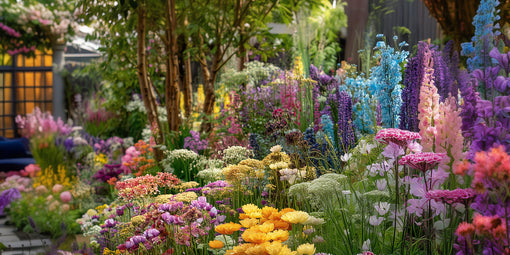
- Article published at:
Drawer menu
It’s not quite that time of year again, but it’s definitely the time to start thinking about what you should plant in your garden to get some colour over the dark winter months.
As we bid farewell to the summer it is important to begin planting the perfect plants and bulbs to carry us through autumn and winter. For the best look, we suggest you do a little forward planning to ensure that the plants you choose can survive the harsh winter weather.
September is actually a great time to plant: the soil is still warm and there should be enough rain to get everything bedded in. Scroll down to find a list of the top autumn-flowering plants to grow in your garden.
Whether you’re a novice or experienced gardener, these autumn plants will help to make your green areas thrive. Some of these though little plants and shrubs can survive the changing weather and brave the cold and wind to bring a splash of colour and brighten breezy autumnal days.

Crocuses are best known for their ability to blossom in the autumn weather. The autumn weather forces their blooms out through the fallen leaves to create a beautiful colour that will brighten up any garden.
It is a good idea to plant these flowers underneath trees as they can be spoilt by heavy rain.

Dahlias are best for working as a border as other plants begin to tire. Though they begin to bloom during the hot summer months, these flowers are at their best from August to September.
This plant comes in extremely exotic colours, so works incredibly well to create a colourful theme throughout your garden. Dahlias come in a variety of sizes from dwarf to XXL, so choose wisely.

This is without a doubt the most elegant autumn flower around today. With an amazing fragrance and long slender stems, it looks gorgeous in the garden. Gladiolus murielae thrives most during the autumn months.

This hardy flower can often be found on moors as it’s a versatile plant that’s able to handle inclement weather. The heather’s vibrant pink, white and purple petals mean it’s an excellent plant for low-growing textures and it looks great in pots too.

Cyclamen is a well-loved hero of the plant world since it blooms from autumn through to spring. Its flowers come in red, pink and white shades and look fantastic in pots or planted under trees.
Cyclamen hederifolium is the usual choice for autumn flowers as it remains relatively unscathed through the winter weather.

The Snowdrop is the classic winter bulb, with its beautiful fragrance and stunning looks. The best way to plant the seeds are to scatter them and plant them where they land as this provides a natural look which complements the flower.

This is an old-fashioned bedding plant, long known for its versatility and tolerance of neglect. The "dusty millers" intensely silver foliage is a great backdrop for other colourful flowers or along with white flowers to create an icy look during the winter.
As you can see there are quite a few plants to choose from when creating your winter garden. Many of them with bright and cheerful coloured blooms. It all depends on what theme you are going for and what container, spot in the garden, you are planting the plant in. Just roll up your sleeves and get creative!
Looking for flowers with same day delivery? We at LOV Flowers are happy to announce we now deliver same day within London! Simply place your order before 1pm Monday to Friday.
If you need your flowers sent anywhere else in the UK, our free next day flower delivery is available.